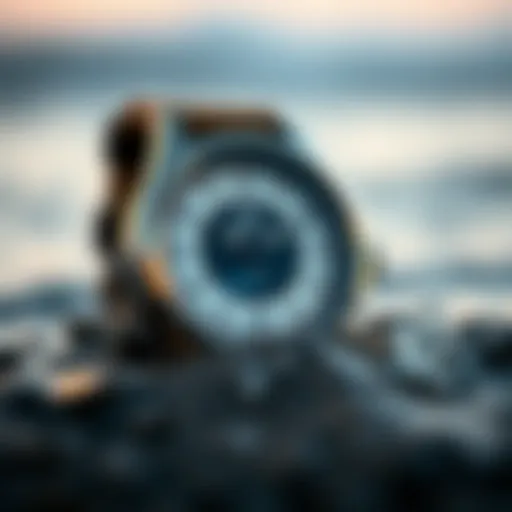The Complete Guide to DB Skimboarding Techniques
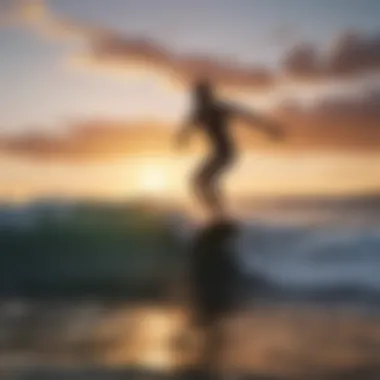

Intro
DB skimboarding, a thrilling blend of agility and balance, invites both newcomers and seasoned riders to the water's edge. This guide aims to unravel the intricacies of this exhilarating sport, offering insights into its history, various techniques, equipment recommendations, and its cultural relevance. Whether you've never set foot on a skimboard or you're entangled in the pursuit of mastering complex aerial maneuvers, this comprehensive overview is designed to elevate your understanding and enjoyment of skimboarding.
At its core, soak in the essential elements that shape DB skimboarding. Starting from the basics to advanced skills, we've got it all laid out for you. Before diving headfirst into the waves, let's take a moment to delve into some critical techniques that will make your skimboarding journey smooth as silk.
Surfing Techniques
Advanced Maneuvers for Experienced Surfers
As you graduate from the basics, refining your moves becomes paramount. Experienced skimboarders often experiment with a range of advanced maneuvers. Some of these tricks include:
- Spin - Executing a smooth 360-degree rotation can be both a stunning visual and an exhilarating challenge.
- Shuvit - A solid trick that involves popping the board and spinning it underneath you while you remain in the air.
- Layback Slide - Gaining a sense of style, this technique involves leaning back while sliding the board.
Trials and errors are part of the game, so don't shy away from landing in the water occasionally. Each splash teaches you something new.
Beginner Tips for Catching Your First Wave
Hitting the water for the first time? It's essential to build confidence through simple yet effective tips:
- Pick Your Spot: Find a shallow area with gentle waves. Shallow spots will allow you to practice without the fear of a deep plunge.
- Get a Feel: Before catching any waves, try walking on the board on dry land to get used to the balance.
- Timing is Everything: Spot your wave and time your run towards it wisely. Preparation is key to catching that first thrilling ride.
Remember, it's all about practice. In no time, you'll be dancing on the waves and enjoying the rush.
"The key to success is to start before you are ready." – Author Unknown
Gear and Equipment Reviews
In-Depth Review of the Latest Surfboards
Selecting the right skimboard can significantly influence your experience. A wide variety of boards is available, tailored to suit different skill levels and environments. Key aspects to consider include:
- Material: Boards commonly made from foam, wood, or fiberglass offer a range of durability and performance. The choice of material affects how the board reacts in water.
- Size: Longer boards usually provide more stability, while shorter ones can be more agile.
- Shape: A wider nose may improve paddling, aiding beginners in catching waves.
It’s best to test out a few different boards to see which fits your preferences. Local surf shops often allow demos.
Essential Accessories Every Surfer Should Have
While picking the right board is vital, don’t overlook the importance of accessories. Some essentials include:
- Skimboard Wax: Helps improve grip on the board, especially crucial in some tricky situations.
- Sun Protection Gear: A quality rash guard or UV-blocking swimwear prevents sunburn.
- Water Shoes: Offering protection from rocky shorelines and giving extra grip when running.
In summary, honing your skills in DB skimboarding while investing in the right gear can significantly enhance your experience. With a solid grasp on essential techniques and the right equipment, you are well on your way to becoming a proficient skimboarder, ready to tackle the waves with flair.
Understanding Skimboarding
Grasping the essence of skimboarding sets the stage for a deeper appreciation of this water sport. Understanding skimboarding not only highlights what enthusiasts find rewarding about the activity, but it also paints a clearer image of the skills, techniques, and culture surrounding it. Whether you're a beginner gearing up to step on a board for the first time or a seasoned rider looking to sharpen your edge, the fundamental concepts of skimboarding are vital. The mix of technique, timing, and personal flair characterizes this sport, allowing one to express themselves while riding the waves and sand.
What is Skimboarding?
Skimboarding is a water sport that practically invites you to play on the shoreline. Picture this: the ocean gently kisses the sand, creating a shimmering pool inviting adrenaline seekers to skim across the surface. At its core, skimboarding involves gliding across thin layers of water—often very close to the beach—using a board designed specifically for this thrill. Riders toss their skimboards onto wet sand and leap aboard, either riding waves back towards the beach or merely enjoying the slide and tricks that can be performed on flat water.
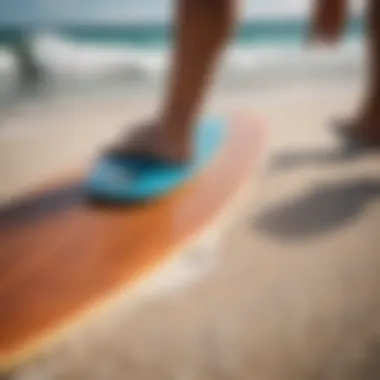

Despite its simplicity, skimboarding demands a unique combination of balance, timing, and agility. Riders can choose to surf waves like traditional surfers or perform tricks on sand or shallow water. This versatility adds layers of excitement.
The Evolution of Skimboarding
Skimboarding isn’t a new venture; its roots trace back to the tranquil beaches of California in the late 1920s and early 1930s. Initially used by surfers to gain a grip on the sand, skimboards were not sophisticated. Wood dominated the market, leading to simple designs and styles. However, as time rolled on, innovations sprouted.
By the late 20th century, skimboarding saw transformational changes. The advent of fiberglass boards allowed for lighter, stronger designs, making it easier to perform aerial tricks. Fast forward to today, and we see a variety of skimboards available, each tailored for specific styles, from flatland tricks to heavy-duty wave riding. The sport continues to evolve with technology, absorbing influences from surfing and other watersports. It’s widely embraced, attracting those who seek both competitive edges and a recreational escape.
The Role of DB in Skimboarding
DB holds a pivotal place in the paradigm of skimboarding. Well-recognized for their commitment to quality, DB skimboards integrate innovative technology with practical design. Their boards cater to a range of skill levels and riding styles, from ambitious beginners to pro skimboarders looking for performance enhancement.
Their thoughtfully designed boards are not just about aesthetics. Each model addresses specific needs, from stability in gliding to responsiveness during tricks. Furthermore, DB actively engages with the skimboarding community through events, competitions, and social media, fostering a sense of belonging among riders.
In summary, to understand skimboarding is to appreciate its origins, evolution, and the brands that propel it forward, like DB. By grasping these elements, riders are better equipped to select gear, hone their skills, and connect with the vibrant culture that defines this thrilling sport.
Techniques and Approaches
The world of skimboarding is as dynamic as the waves it rides on. To truly appreciate this sport, one must understand the various techniques and approaches that form its foundation. Whether you’re just starting or looking to polish your skills, how you approach skimboarding can greatly affect your overall experience and performance. Proper technique doesn’t just enhance your enjoyment; it also helps prevent injuries and builds confidence. Mastering these elements can lead to smoother rides, more impressive tricks, and a deeper connection with the aquatic environment.
Basic Skimboarding Techniques
At the outset, learning basic skimboarding techniques is akin to learning to walk before you run. Here, the focus lies on core skills that lay the groundwork for future progression.
- Foot Placement: One of the first things to consider is where to place your feet. Correct foot positioning can significantly impact your balance and control. Typically, you want your back foot near the tail of the board for stability, while your front foot should be positioned towards the center, helping to guide your movement.
- Launching Techniques: Learning to launch your skimboard effectively is vital. Stand at the water’s edge, place your board on the wet sand, and get a running start. As you hit the water’s edge, hop onto the board and keep your weight balanced. Getting this right can turn a wobbly start into smooth sailing.
- Stopping Techniques: Knowing how to come to a stop might sound simple, yet it’s crucial. As you glide, bend your knees and lean back to slow down gradually. The goal is to avoid jarring stops that can lead to spills.
Intermediate Skill Development
Once you’ve nailed the basics, it’s time to tackle intermediate skill development. This stage is all about refining techniques and adding a bit of flair.
- Pushing Off: As you launch, consider using your back foot to push against the board. This technique adds momentum and stability, giving you the edge when riding out.
- Turning Techniques: Angling your body for turns can enhance your agility. By shifting your weight from your toes to your heels, you can cut sharper corners and maintain speed. Incorporating side-to-side movements fosters a fluidity that feels natural in the water.
"Practicing these intermediate skills not only boosts performance but also enhances the thrill of skimboarding. Your confidence will grow, pushing you to try more challenging moves."
Advanced Maneuvers
For those ready to dive into the deep end, advanced maneuvers represent the pinnacle of skimboarding skill. This is where you can really showcase personality and creativity while riding the waves.
- Shuvits and Spins: At this level, tricks like shuvits can captivate onlookers. The key to performing these tricks lies in timing and board control. You'll want to wind up, pop the tail down, and use your back foot to snap the board around in the desired direction.
- Wave Riding: Advanced skimboarders often venture out onto the waves. Knowing how to read the water, catch the right wave, and position yourself correctly is essential at this stage. The balance between speed and angle is critical in ensuring a successful ride.
- Inverts and Flip Tricks: If you're feeling bold, you might want to attempt inverts or flip tricks like the kickflip. These require not only dexterity but also considerable practice to master the timing of your motions.
Overall, advancing in skimboarding means pushing your limits while continuously improving your understanding of water dynamics and board control. Mastery of these techniques opens a world of possibilities, adding excitement and thrill to an already exhilarating sport.
Types of DB Skimboards
Understanding the different types of DB skimboards is fundamental for anyone looking to enhance their experience in the sport. Not only does the type of skimboard influence performance, but it can also affect safety and skill development. Recognizing the differences among skimboard types allows you to choose the right equipment tailored to your specific needs and style.
Differences Between Skimboard Types
When discussing skimboards, it is crucial to recognize that not all boards are created equal. Each type serves a unique purpose and is designed with specific features that cater to different riding conditions and styles.
- Standard Skimboards: These boards are typically made from wood or foam. They're ideal for beginners and moderate waves, offering lightweight construction and ease of use. The more traditional wood boards provide a smooth ride on flat water.
- Wider Boards: Wider boards provide increased stability and are often used in thicker waves, making them excellent for riders who haven't yet mastered balance on a skimboard.
- Pro Models: Made for the experienced skimboarder, pro models often feature advanced materials like fiberglass and carbon fiber, providing superior strength and responsiveness. These boards excel in complex maneuvers and are often the choice for competitive riders.
- Hybrid Boards: Combining features from both skim and surfboards, hybrid boards are designed for versatility in various conditions. They are suitable for riders who enjoy experimenting with different styles.
- Foam Boards: These are ideal for young children or those just starting out. They provide a forgiving surface and are less likely to cause injury, but typically offer less performance than harder materials.
Each of these boards comes with its own set of advantages and drawbacks, making it essential to understand what matches your level and the conditions you’ll be riding in.
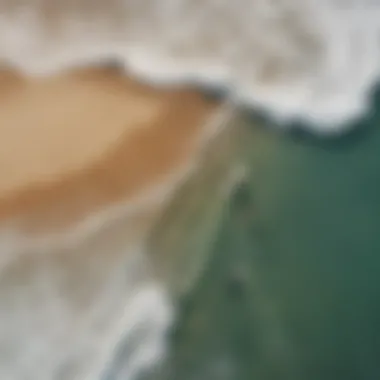

Choosing the Right Type for Your Style
Selecting the right skimboard for your riding style can make all the difference between a frustrating experience and pure exhilaration. Here are a few key considerations to help guide your selection:
- Skill Level: If you're just starting out, a standard or foam board might be your best bet for learning the basics. Conversely, those with more experience might lean towards pro models for advanced tricks.
- Riding Conditions: If you’re riding in waves, consider a wider or hybrid board for enhanced stability. In flat conditions, a standard or smaller pro model may serve you better allowing faster maneuvering.
- Personal Preference: Ultimately, your comfort and preference plays a substantial role. Test different boards to see what feels best under your feet.
"The right board can transform your skimboarding experience. It's akin to finding the perfect pair of shoes; comfort and fit matter."
Don't shy away from reaching out to local skimboarding communities to gather feedback on which boards work best in your area. Engaging with veterans can offer invaluable insights that may not be evident at first glance. Remember, the right choice is often personal and may require experimentation to discover what meshes perfectly with your style.
Gear and Equipment Review
Understanding the right gear and equipment for skimboarding can have a profound impact on not only your performance but also your overall enjoyment of the sport. This section delves into the essentials of skimboard construction, a review of the top DB skimboards available, and the accessories that can enhance your experience on the water. Choosing the proper gear is akin to having a trusty map when navigating uncharted waters; it sets the stage for exploration and adventure.
Understanding Skimboard Construction
Skimboards come in various shapes, sizes, and materials, all vital for determining how they perform on the water. Generally, skimboards are made from wood, foam, or fiberglass, each offering different benefits.
- Wooden boards are great for beginners due to their sturdiness, but they can be heavier, which may not suit advanced maneuvers.
- Foam skimboards are typically lighter and can float, making them easier for newer riders. However, they may lack the speed of harder materials.
- Fiberglass boards are often favored by experienced skimboarders due to their lightweight feel and ability to cut through the water more efficiently.
When selecting a skimboard, consider the thickness and width as well. A thicker board gives more stability, while a thinner one allows for agility, especially crucial when performing tricks. Pay attention to the tail shape, whether it's a swallow tail for turns or a square tail for speed, it can make a big difference in your performance.
Top DB Skimboards on the Market
Having the right skimboard can truly make or break your session at the beach. Here are some notable DB skimboards that stand out in the market today:
- DB Skimboards’ Pro Model 42
A high-performance board preferred by seasoned riders. Its lightweight construction allows for high-speed passing and sharp maneuvers. - DB Skimboards’ Splash 39
A staple for newcomers, it combines durability and user-friendly design, allowing smooth rides and great stability. - DB Skimboards’ Wave Rider 40
This board excels in variable wave conditions, featuring a versatile build that caters to all skill levels. - DB Skimboards’ Carbon Fiber 44
The ultimate choice for those looking for speed and precision. It's engineered for cutting through waves with its sleek, aerodynamic form.
For an in-depth look at any specifications or user feedback, you might check out platforms like Reddit where enthusiasts discuss their experiences.
Essential Accessories for Skimboarding
Accessories can enhance your skimboarding experience just as much as the board itself. Here’s a list of some essentials:
- Skimboard wax: Keeps your feet from slipping off and provides that extra grip when you need it most.
- Board bag: Protects your skimboard from scratches and dings while transporting it to your favorite beach. Look for padded options for added safety.
- Wetsuit: Depending on the water temperature, a decent wetsuit can keep you warm and help maintain your stamina when you’re out in the water for long periods.
- Adhesive pads: Beach surfaces can be rough, and placing pads on your board can make it more comfortable and help prevent injuries.
"Investing in quality gear can elevate your skimboarding experience, transforming the ride from merely fun into pure exhilaration."
Before diving into the waves, meticulously check your gear and accessories. Skimboarding is not only about the thrill but also making the most out of every moment spent on the beach.
Safety and Environmental Considerations
Understanding the safety and environmental factors in skimboarding is crucial for ensuring a rewarding and responsible experience. Safety measures protect riders, while environmental awareness fosters a sustainable approach to the sport. As skimboarding gains popularity, recognizing the impact on both personal safety and the natural surroundings becomes increasingly important.
Safety Gear Essentials
When it comes to enjoying skimboarding safely, gear plays an essential role. Using appropriate safety equipment helps prevent injuries and enhances the overall experience. Here are some must-have items:
- Skimboard Specific Wetsuit: A well-fitting wetsuit not only keeps you warm in cold water but also provides protection against scrapes and impacts. Consider choosing one that is flexible enough to allow for movement while remaining durable.
- Helmet: Many skimboarders overlook the importance of a helmet. A good quality helmet safeguards your head during falls or collisions. Look for one designed specifically for water sports.
- Water Shoes: Protect your feet from sharp shells and rocky terrains with sturdy water shoes, allowing you to maneuver on various surfaces without worry.
- Life Jacket: For those who are less experienced or riding in deeper waters, wearing a life jacket can be a wise choice. It adds an extra layer of safety.
Keeping your gear well-maintained is just as important as having the right equipment. Regular checks for wear and tear can ensure your safety on the water.
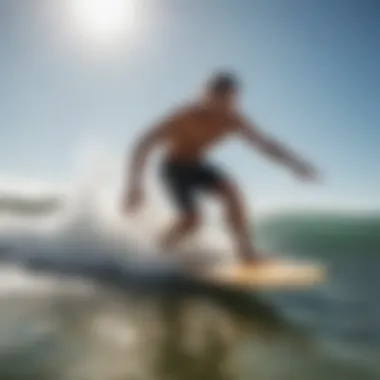

Environmental Impact of Skimboarding
Skimboarding, while a thrilling water sport, can have unseen consequences on the environment. Understanding these impacts is vital for all enthusiasts. Here are some major concerns:
- Erosion: Frequent skimboarding in certain locations can lead to erosion of beaches, affecting habitats and local ecosystems. The waves created by skimboarders can wash away sand, causing shifts in the natural landscape.
- Wildlife Disruption: Skimboarding near nesting areas may disturb local wildlife, particularly birds. Keeping a respectful distance from these areas can help protect the habitats.
- Waste and Pollution: Many beachgoers unintentionally leave behind trash or gear remnants. It’s crucial to leave the beach cleaner than you found it. Picking up after yourself not only maintains the beauty of the locations you enjoy but also preserves them for future generations.
Sustainable Skimboarding Practices
With the impact of skimboarding in mind, adopting sustainable practices is key. Here are some efforts that can be made:
- Choose Eco-Friendly Gear: Opt for skimboards and accessories made from sustainable materials, avoiding products that might harm the environment. This approach can also support brands that prioritize eco-conscious manufacturing processes, such as those using recycled materials.
- Participate in Beach Cleanups: Joining local efforts to clean beaches helps mitigate the negative impact and fosters a sense of community among skimboarders. Organizing or participating in these activities encourages a culture of stewardship.
- Stay Informed: Keeping up with local regulations regarding skimboarding can inform you of protected areas and inform best practices for enjoying the sport responsibly.
"Every wave we ride leaves footprints in the sand. It’s our duty to ensure those footprints inspire the next generation to cherish our coastlines."
Striving for safety and environmental consideration in skimboarding allows you to engage fully with the sport while ensuring it thrives for years to come. A little knowledge and care can go a long way.
The Skimboarding Culture
Skimboarding is more than just a sport; it embodies a lifestyle that resonates deeply with the ocean's rhythm. The culture surrounding skimboarding is a melange of camaraderie, collective passion, and respect for nature. Often overlooked, this aspect plays a pivotal role in how enthusiasts approach the sport and its community.
Community and Events
Skimboarding communities thrive on shared passion, creating spaces for individuals to connect over their love for this exhilarating activity. Local skimboarding spots often become hubs where riders gather to exchange tips, celebrate successes, and foster friendly competition. Events like skimboarding contests or beach clean-ups are commonplace, often drawing both seasoned veterans and curious newcomers.
Participation in organized events not only sharpens skills but strengthens community bonds. These gatherings are typically relaxed, emphasizing fun and experimentation rather than pure competitiveness. From amateur contests in small coastal towns to professional championships that attract top-tier athletes, events contribute to the culture, creating lasting memories and connections.
Influential Figures in Skimboarding
The landscape of skimboarding has been shaped by several influential figures who have made significant contributions to both the sport and its culture. Riders like Blake Cohen and Eric T. have both inspired many through their techniques and personality, proving that style and creativity are as important as skill in skimboarding.
Moreover, these figures often serve as mentors to the younger generation, passing down knowledge and encouraging them to develop their own unique style. Their impact resonates beyond personal achievements; they attract a newer audience to the sport, helping to continually grow the community.
The Future of Skimboarding
As skimboarding gains recognition, it stands on the brink of exciting transformations. With advancements in technology, new skimboard designs are emerging, tailored to enhance performance and adapt to varying environmental conditions. Riders are increasingly conscious of environmental impacts, opening dialogues about sustainable practices within the sport.
Also, the digital age plays a substantial role in the future of skimboarding. With platforms like Reddit and Facebook, communities can share tips, videos, and motivation across vast distances, creating an interconnected global network of skimboarders. This accessibility can encourage budding enthusiasts to dive into the sport, fostering its growth.
The culture of skimboarding thrives on innovation while honoring its roots. As awareness of environmental sustainability increases, discussions around eco-friendly materials and practices are becoming central to the skimboarding community. In the grand scheme, it represents an evolving culture – one that balances monumental growth while remaining true to the ethos of respect for the ocean and camaraderie among riders.
"Skimboarding is really about the connections we make and the waters we ride. It’s more than just a sport; it’s a way of life."
Whether participating in local events, following influential riders, or advocating for the sport's future sustainability, every action contributes to shaping the narrative of skimboarding culture. Through these collective efforts, skimboarding continues to evolve, promising a bright future for both the sport and its players.
Frequently Asked Questions
Skimboarding, especially DB skimboarding, is a thrilling water sport that often leaves newcomers and enthusiasts alike with a slew of questions. This section aims to answer those burning queries, enriching your understanding and appreciation of the sport. Addressing frequently asked questions is crucial; it promotes an informed community, aids technique refinement, and ultimately enhances the overall skimboarding experience.
Common Skimboarding Queries
- What is the best time to skimboard?
The ideal conditions for skimboarding generally coincide with low tide. This is when the shore is filled with wet sand, providing the perfect bounce for the board. Early mornings or late afternoons can be gorgeous, too, with fewer people around and a breathtaking view. - How do I maintain my skimboard?
Keeping your board in great shape is essential for both performance and longevity. After each session, rinse it with fresh water to remove salt and sand. Store it in a cool, dry place out of direct sunlight. Avoid dropping it on hard surfaces, as that can cause dings. - Can I skimboard on any beach?
Ideally, look for sandy beaches with a gradual slope. Rocky shores can be detrimental and dangerous for your board and yourself. Some beaches have regulations, so it’s wise to check local guidelines as well. - What kind of skimboard should I start with?
Beginners often do best with a wider board for stability. Look for options from makers like DB that offer durable and user-friendly designs. Steering clear of competition-level boards initially helps focus on learning. - Are there competitions for skimboarding?
Yes, skimboarding competitions happen all over the globe, drawing both amateurs and seasoned pros. These events not only push the sport's boundaries but also foster a delightful community vibe.
Resources for Further Learning
To deepen your knowledge and skills beyond the basics, tap into the following resources:
- For history and technique, Wikipedia offers a solid foundation.
- The Britannica provides educational content suitable for varying levels of interest.
- Community advice and discussions can often be found on platforms like Reddit which have dedicated skimboarding subreddits.
- Social networks like Facebook often host groups for local and international skimboarders to share tips, event details, and their experiences.
By utilizing these resources, you can continue learning and engage more effectively within the exciting world of skimboarding.









